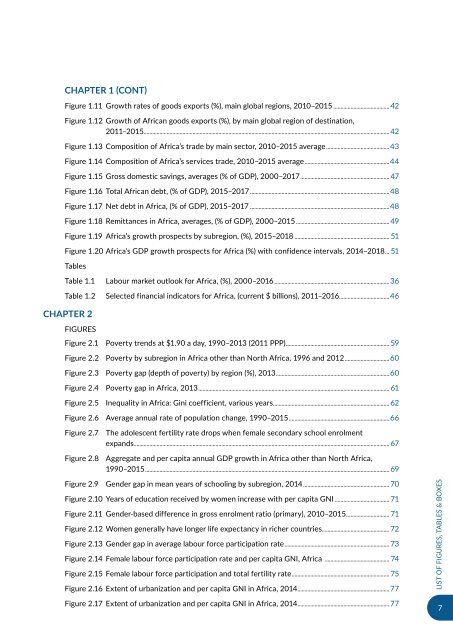URBANIZATION AND INDUSTRIALIZATION
Economic%20Report%20on%20Africa%202017%20UNECA
Economic%20Report%20on%20Africa%202017%20UNECA
Create successful ePaper yourself
Turn your PDF publications into a flip-book with our unique Google optimized e-Paper software.
CHAPTER 1 (CONT)<br />
Figure 1.11 Growth rates of goods exports (%), main global regions, 2010–2015........................................ 42<br />
Figure 1.12 Growth of African goods exports (%), by main global region of destination,<br />
2011–2015........................................................................................................................................................................... 42<br />
Figure 1.13 Composition of Africa’s trade by main sector, 2010–2015 average.............................................43<br />
Figure 1.14 Composition of Africa’s services trade, 2010–2015 average............................................................44<br />
Figure 1.15 Gross domestic savings, averages (% of GDP), 2000–2017............................................................... 47<br />
Figure 1.16 Total African debt, (% of GDP), 2015–2017..................................................................................................48<br />
Figure 1.17 Net debt in Africa, (% of GDP), 2015–2017..................................................................................................48<br />
Figure 1.18 Remittances in Africa, averages, (% of GDP), 2000–2015.................................................................. 49<br />
Figure 1.19 Africa’s growth prospects by subregion, (%), 2015–2018................................................................... 51<br />
Figure 1.20 Africa’s GDP growth prospects for Africa (%) with confidence intervals, 2014–2018.... 51<br />
Tables<br />
Table 1.1 Labour market outlook for Africa, (%), 2000–2016.................................................................................36<br />
Table 1.2 Selected financial indicators for Africa, (current $ billions), 2011–2016...................................46<br />
CHAPTER 2<br />
FIGURES<br />
Figure 2.1 Poverty trends at $1.90 a day, 1990–2013 (2011 PPP)......................................................................... 59<br />
Figure 2.2 Poverty by subregion in Africa other than North Africa, 1996 and 2012................................60<br />
Figure 2.3 Poverty gap (depth of poverty) by region (%), 2013................................................................................60<br />
Figure 2.4 Poverty gap in Africa, 2013...................................................................................................................................... 61<br />
Figure 2.5 Inequality in Africa: Gini coefficient, various years.................................................................................. 62<br />
Figure 2.6 Average annual rate of population change, 1990–2015.......................................................................66<br />
Figure 2.7 The adolescent fertility rate drops when female secondary school enrolment<br />
expands................................................................................................................................................................................... 67<br />
Figure 2.8 Aggregate and per capita annual GDP growth in Africa other than North Africa,<br />
1990–2015........................................................................................................................................................................... 69<br />
Figure 2.9 Gender gap in mean years of schooling by subregion, 2014.............................................................70<br />
Figure 2.10 Years of education received by women increase with per capita GNI....................................... 71<br />
Figure 2.11 Gender-based difference in gross enrolment ratio (primary), 2010–2015............................... 71<br />
Figure 2.12 Women generally have longer life expectancy in richer countries............................................... 72<br />
Figure 2.13 Gender gap in average labour force participation rate.......................................................................... 73<br />
Figure 2.14 Female labour force participation rate and per capita GNI, Africa .............................................. 74<br />
Figure 2.15 Female labour force participation and total fertility rate..................................................................... 75<br />
Figure 2.16 Extent of urbanization and per capita GNI in Africa, 2014.................................................................77<br />
LIST OF FIGURES, TABLES & BOXES<br />
Figure 2.17 Extent of urbanization and per capita GNI in Africa, 2014.................................................................77<br />
7


